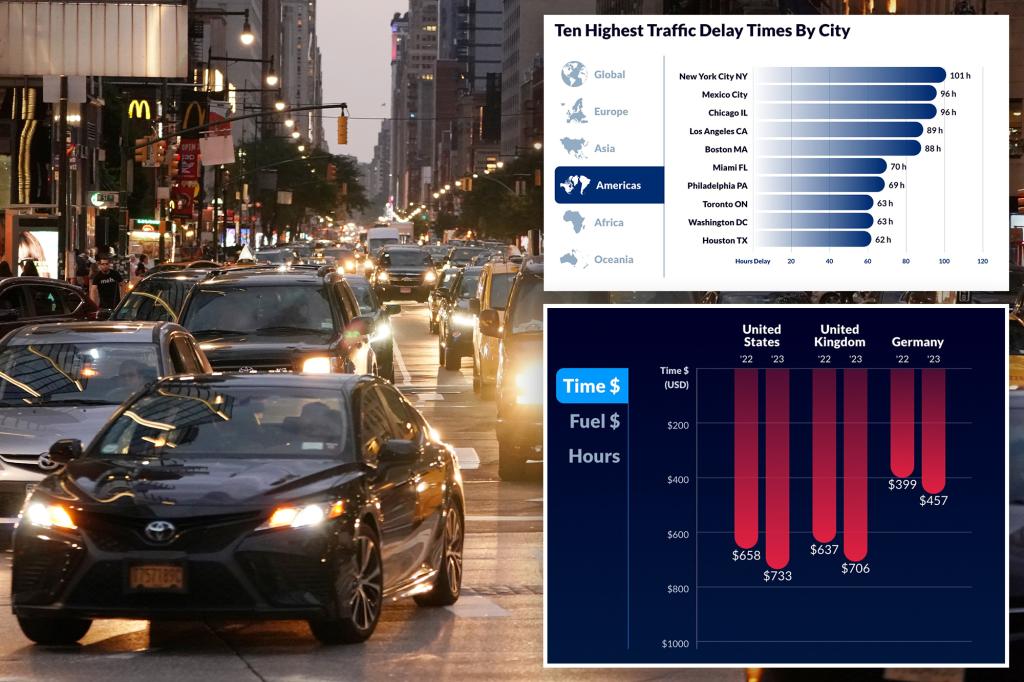For the second consecutive year, New York City has been ranked as having the worst congestion in the world, with drivers spending an average of 4 days stuck in traffic at a cost of over $9 billion to the city. Data collected by the transportation analytics firm INRIX’s Global Traffic Scorecard found that drivers in the New York metro area lost 101 hours behind the wheel sitting in traffic jams last year. The report collected data from 947 urban areas in 37 countries to compare travel delays, costs, and commuting trends, with New York City topping the list with a loss of $9.1 billion due to congestion, equivalent to $1,762 per driver.
The study also revealed that the average speed within one mile of the downtown core was 11 mph, with drivers reaching an average of 15 mph during peak hours and 30 mph during the low point between morning and afternoon commutes. Bob Pishue, a transportation analyst at INRIX, stated that traffic congestion serves as both a symbol of bustling economic activity and a hindrance to it. While the surge in traffic congestion in urban areas post-COVID indicates a revival of economic activity, it also resulted in billions of dollars in lost time for drivers. Despite a slight improvement from the 2022 congestion report where drivers lost 105 hours, the numbers from 2023 were still 11% higher than those gathered during the COVID-19 pandemic, suggesting a return to pre-pandemic congestion levels.
New York City was ranked as the worst city in the world for congestion compared to other cities in the United States, surpassing Chicago, Los Angeles, Boston, and Miami. The city’s busiest road was identified as a four-mile stretch on the Brooklyn-Queens Expressway (I-278) from the LIE to Tillary St, with 82 hours lost during the commute. The report also highlighted the busiest corridor in the nation, which was awarded to I-4 W in Orlando, Florida, passing Universal Orlando, where motorists lost 31 hours at peak time and 124 hours in total last year. The data suggested a return to pre-pandemic congestion levels, with New Yorkers losing 140 hours in 2019, compared to 101 hours in 2023.
New Yorkers faced the fear of the proposed MTA congestion pricing, which would charge drivers $15 to enter Midtown Manhattan south of 60th Street. Governor Kathy Hochul recently suspended the plan, which was initially set to go into effect on June 30. The MTA board is expected to approve a resolution acknowledging that the congestion toll will not be implemented in June 2024 due to the pause in the program. Hochul cited the cost-of-living crisis in New York as the reason for pausing the capital plan, which was expected to generate $1 billion in revenues a year to finance $15 billion in capital repairs, maintenance, upkeep, and system expansion. The congestion pricing plan aimed to alleviate traffic congestion in Manhattan while providing funding for essential transportation infrastructure projects.
In conclusion, New York City’s ranking as having the worst congestion in the world highlights the challenges faced by drivers in the city, with significant time and financial costs associated with sitting in traffic jams. The data collected by INRIX’s Global Traffic Scorecard underscores the impact of traffic congestion on economic activity and the daily lives of residents. The proposed MTA congestion pricing plan, which aimed to address congestion while providing revenue for critical infrastructure projects, has been paused due to the current economic challenges faced by New Yorkers. Moving forward, city officials will need to address congestion issues while balancing the financial burdens on residents to ensure sustainable and efficient transportation systems in New York City.


